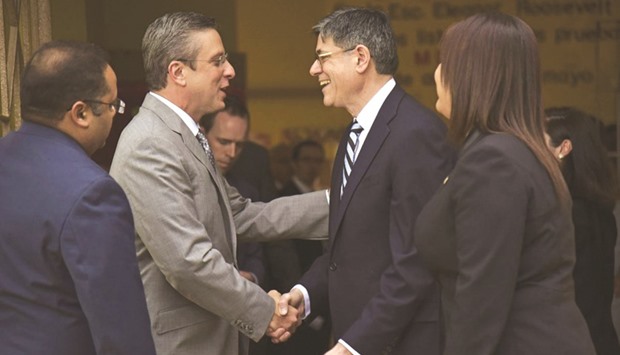Puerto Rico’s outgoing governor, Alejandro Garcia Padilla, presented a fiscal turnaround plan on Friday to a federal oversight board, stating if “things do not change” the island faces a 10-year cumulative budget deficit of $34bn.
Garcia Padilla reiterated that the US territory’s near $70bn debt load was not sustainable even with tax increases and other revenue-boosting measures implemented in the last two years. Bondholders later were critical of his presentation.
If Puerto Rico were to lose its current level of federal support from the Affordable Care Act and other measures, the cumulative deficit would rise to $59bn.
“And, even if spending is reduced to pay the debt, you will soon realise that any reduction in spending implies intolerable effects in aggregate demand and will further throw Puerto Rico into a death spiral that will directly affect creditors’ recoveries across the board,” Garcia Padilla said.
The turnaround plan, a vision of how to right Puerto Rico’s economic ship, is a requirement of the Puerto Rico rescue law known by its acronym, PROMESA, signed by president Barack Obama this year.
Under PROMESA, federal officials appointed the seven-member oversight board charged with helping Puerto Rico get its house in order by working with the governor on a fiscal plan, approving annual budgets and facilitating debt restructuring talks with creditors.
Protesters interrupted the public meeting with shouts of “shame on you,” as they did during the first board meeting last month. Many in Puerto Rico are critical of the unelected board, calling it an attack on sovereignty.
The island, trudging through a decade of economic contraction in addition to the massive debt, struggles with a poverty rate of 45% and dwindling population as locals flee for the US mainland.
Puerto Rico has defaulted on $1.375bn in principal and interest on its debt. Even without servicing debt of more than $34bn over a 10-year period, Puerto Rico still would have a $6bn deficit, Garcia Padilla said.
Without specifying how much of the $70bn debt he believes should be trimmed, Garcia Padilla said the debt service-to-revenue ratio should not exceed 15%.
The impact of the plan is unclear. The governor is not seeking reelection on November 8. His successor, likely to come from a more creditor-friendly opposition party, could make significant changes.
A group of investors calling themselves the Ad Hoc Group of Puerto Rico’s General Obligation Bondholders, who confirmed with Reuters they hold several billion dollars worth of debt, issued a statement panning Garcia Padilla’s presentation.
The group said Garcia Padilla demonstrated “a wholesale disregard for fiscal soundness, factual accuracy, and his obligations under PROMESA and Puerto Rico’s Constitution. We look forward to working with the Oversight Board and the next governor to reach a solution for Puerto Rico”.
A source close to the group said it includes Aurelius Capital Management, Autonomy Capital (Jersey), Covalent Partners, FCO Advisors, Monarch Alternative Capital and Stone Lion Capital Partners.
Puerto Rico’s economy contracted in nine of 10 years from 2006 through 2015. Garcia Padilla said the problems did not accumulate overnight and did not stem from any single factor, political decision or party.
“Rather they are the culmination of decades of misguided and unscrupulous public policies in San Juan, Wall Street and Washington,” he said, pointing at all actors in the crisis.
Garcia Padilla restated the need for congress to fund Puerto Rico’s Medicaid and Medicare systems and pay its pensioners.
Puerto Rico receives less federal Medicaid reimbursement than US states. The U.S. government foots about $335mn of Puerto Rico’s Medicaid bill, or about 12% while the poorest US states receive 75% reimbursement.
Under the plan submitted on Friday, Puerto Rico is requesting the removal of statutory limits on Medicaid funding.
Its public pensions, which cover more than 330,000 workers and retirees, are underfunded by some $45bn, a 96% shortfall that is among biggest in US history. Those obligations are separate from $70bn of bond debt. Debt to vendors stands at about $1.3bn.

Treasury secretary Jacob Lew with Puerto Rico’s Governor Alejandro Garcia Padilla.
